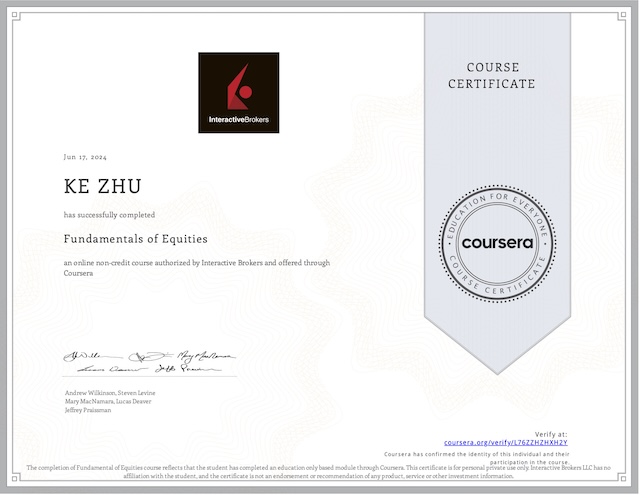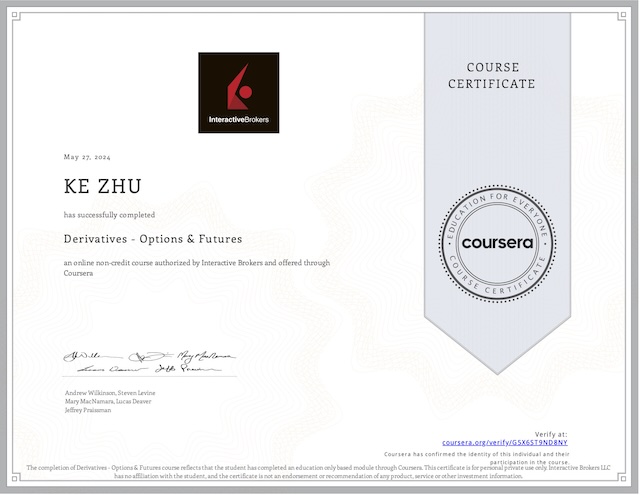Interest Rates
Saving Accounts
After the financial crisis of 2008 and 2009, the current economic situation is rather different from the past, say 1980s. At that time, banks offered passbook savings account with a 7.4 per annum interest rate. Usually the service has a term in the fine print, for example the stated term is three months. That means you technically, they might make you wait three months to get your money out. The term of any contract is the time that you have to keep your money in it and can’t get it out.
But you won’t see savings accounts today, because it doesn’t exist anymore. Now the secret is if you want something like this, you’re going to have to pay a negative interest rate. This saving account business just doesn’t pay because interest rates at the short end have gotten very low. We are in a situation in which at the short term, interest rates are virtually 0. It’s a historic event.
Federal Funds Rate
The shortest term interest rate in the United States is called the Federal Funds Rate, and it’s an overnight rate. Banks are the ones who deal in this, because individuals normally don’t borrow money overnight. It’s been at zero ever since the crisis in 2008.
European Overnight Index Average (EONIA) is the same thing – about zero after the crisis, and downward path since 2000. It’s even more interesting, because in the US it stopped at zero. But EONIA hass been negative for over a year. Why does a bank ever invest money at a negative rate when they can just pull the money out and hold cash? Why would a bank lend to another bank at negative? It’s costly to store cash.
“Interest rates tend to be small positive numbers like 3% or 5% because of technical progress, time preferences and advantages to roundaboutness.”
Eugen Bohm von Bawerk in 1884, Capital and Interest
All three of those were causes of interest:
- Technical progress means “It’s because the rate of progress is something like 3%.”
- Time preference is that “People are just naturally impatient.”
- Advantages to roundaboutness is advantages to more delayed and complicated production process.
Compound Interest
If annual rate is r, compounding once per year, balance is (1+r)t after t years. Now the banks often compound more often than once a year, if compounded n times per year, balance is (1 + r/n)nt after t years. As n goes to infinity, you get continuous compounding, then the balance is ert.
Discount Bonds
Bonds typically pay coupons (which you would take to the bank and the bank would then give you the money). At the end of the maturity of the bond, you could take the whole thing back. A discount bond is a bond that carries no coupon. You buy it at a discount and price rises through time, creating income.
If we look at the price of the discount bond, we can infer the yield to maturity from that bond, assuming the principle of bond is 1.
P = 1 / (1 + r)T
where
P : Price
T : Term
r : Yield to Maturity (YTM)But typically bonds pay interest rate every 6 months, you may use P = 1 / (1 + r / 2)2T instead. You could also do it using continuously compounded yield to maturity, P = e-rT.
Now, we can define the present discounted value (PDV) of any cash flow, or the principal after T years for discount bond. Assuming that the discount rate r is the same for all different maturity, the PDV of a stream of cash flow x1, ..., xn is:
PDV = ΣTt=1 xt / (1 + r)tConventional coupon-carrying bonds, which is issued at par ($100), coupon every six months. The price of the conventional coupon-carrying bonds is:
# compounded annually
P = c (1 / r - 1 / (1 + r)T 1 / r) + 100 / (1 + r)T
# compounded six months
P = 0.5c (1 / 0.5r - 1 / (1 + 0.5r)2T 1 / 0.5r) + 100 / (1 + 0.5r)2T
where
P : Price
c : Coupon
T : Term
r : Yield to Maturity (YTM)As T goes to infinity we’re left with c / r, called consol. This formula was sufficiently difficult that in the old days, and people didn’t have calculators. Also you can’t solve this back. i.e. given the price of a bond, it’s not algebraically possible to solve this equation for r.
But nowadays it is possible, so many people think in terms of present values, and they want to know what the Yield to Maturity is, what’s the interest rate on a bond given its price.
Consol and Annuity Formulas
Consol is the one that pays constant quantity x for ever. The price of a consol is
p = x / r
where
x : coupon
r : the yield to maturityIn the 1700s, the government of the United Kingdom issued bonds with no maturity date, they promised to pay this coupon forever. The only way they could get out of it was by buying them back.
The coupon is fixed at the time the bond is issued, but the market price of the bond changes through time. So if the British government issued a 3 pound consol for 100 pounds and that consol is selling for £200 today, the yield to maturity is down to 1.5% instead of 3%. Bonds are risky, they have market risk even if there is no default risk.
Moreover, British government has the coupon on the consol growing at a constant rate, g per year. The growing consol formula is also called the Gordon Rule:
pgrow = x / (r - g)
where
x : coupon
r : the yield to maturity
g: growing rate of xIf g = r, then p is infinite, because the series that you are summing is not convergent. If g > r, the formula breaks down. More interestingly, at the present r is very close to zero, or even negative. If the interest rate is 0 then consols don’t even converge.
Annuity is like a consol except that it stops after a certain number of years. This is different from the present value for a coupon-carrying bond because there’s no principle repayment at the end.
# compounded annually
P = c (1 / r - 1 / (1 + r)T 1 / r)A typical annuity is a home mortgage (the compounding integral is monthly).
Forward Rates
Forward rates are interest rates that can be taken in advance using the term structure. Consider a simple situation: I am in 2022, and want to invest a mount of money to a discount bond in 2023 and money back in 2024. At this moment, 2022, the 1-year spot rate for the bond is r1, and the 2-year spot rate is r2.
| - r2 - - - - - - - - - - - - - - - - - - - |
| - r1 - - - - - - - - | - rf - - - - - - - - | Then the forward interest rate from 2023 to 2024 is:
(1 + r1) (1 + rf) = (1 + r2)2
⟹ rf = (1 + r2)2 / (1 + r1) - 1Inflation
In 1895, John Bates Clark wrote a journal article defining what he called the real interest rate – the interest rate corrected for inflation. So the nominal interest rate is quoted in currency, Dollars, Pounds, Renminbi, whatever. But it’s not corrected for inflation, and as you know when you have inflation, the value of the currency declines.
The real rate is quoted in terms of the market basket that underlies the consumer price index (CPI). The simple way of describing the real rate
Real rate = Nominal rate - Rate of inflationBut actually the formula is like this, nominal rate usually greater than real rate.
(1 + rmoney) = (1 + rreal) (1 + i)
where
rmoney : money rate or nominal rate
rreal : the real rate
i : the inflation rateIndexed bonds are the bonds whose coupons are just tied to the inflation rate.
Leveraging
If a company or an individual borrows money to buy assets, we say that person or company is leveraging. Leveraging means you are putting more money into the asset than you have. That makes you in a riskier situation, both up and down. Leveraging increases risks.
Debt leads to bankruptcy. If you have no debt, you normally don’t go bankrupt, because bankruptcy occurs when your creditors are after you for non-payment and normally, you would just pay them if you had the money. It’s just when you don’t have the money that you are in trouble.
What happens when there’s a huge deflation and consumer price index goes down? That magnifies the real value of the debt. What ends up happening in a deflation is that the debtors get beaten down. The optimists have less wealth in real terms and the pessimists have more. Deflation redistributes real wealth from debtors to creditors.
Corporation
Market capitalization is the price per share multiplied by the number of shares (common stock). The word corporation comes from the Latin word corpus, meaning body. It is an organization that is incorporated, it’s made as if it has a body, as if it’s a person. In fact, the word person in law typically includes corporations. The idea is to create something that legally has a lot of the rights that individuals do.
The modern corporation in the United States, say the for-profit company like those that are on the New York Stock Exchange, is governed by a board of directors that is elected by the shareholders. it’s called shareholder democracy. Typically one share, one vote. The shareholders have the claim on the earnings of the company, and have to pay a corporate profits tax.
You, as a shareholder, vote your shares. “One share one vote” in a company sounds sensible to elect the board of directors. And then the board of directors votes on who will be the president. CEO is hired by the board, serves as an employee, and has to report to the board of directors.
Non-profit means that they don’t distribute profits to shareholders. The purpose is not to distribute profits. Non-profit corporations are not owned by anyone. Non-profits would just be self-perpetuating, that is the directors appoint their own successors. The for-profit exists for shareholders. The non-profit exists for whatever the Charter of the non-profit says, it promotes some cause. For-profits have a price per share. Non-profits are not traded and so they don’t have a price, no price for them.
Shares and Dividends
The corporate law in a state defines the rights and responsibilities of shareholders and the board of directors. Your ownership of company equals your shares divided by total shares. Companies do things called splits, which are essentially meaningless. Why?
It seems that companies think that there’s an optimal price per share that encourages investors look right, feels right. And so they will change the number of shares from time to time, trying to hit a target for the price per share.
Remember we had the return on a corporation has two components:
- the capital gains which is the appreciation in the price per share, and
- the dividends which is a distribution of money from the company’s earnings to its shareholders.
People tend to talk so much about the capital gains. However dividend is actually the whole reason for being for the stock market. In fact, in the history, most of the returns you get on the stock market are in the dividends.
When a company pays a dividend, the share price drops because the company used to have the money and now it doesn’t. It paid it out.
In fact, it’s correct to think that efficient markets implies that what you’re really pricing in the stock market is a claim on dividend. P/E (price earning ratio) is usually something like 15. So you’d buy a share and, if you’re getting all the earnings as dividends, you’d have your money back in 15 years.
In efficient markets, the price of a share is the present discounted value (PDV) of its expected future dividends.
P/E = 1 / (r-g)
where
r : interest rate or discount rate
g : growth rate of earningsIt would say if a company has low P/E, it does not mean that company is a ‘bargain’, that means:
- either r is high – risk is high
- Well if you believe the Standard Theory, we have the security markets line. The expected return on a stock is a function of it’s covariance with the market. Low price earnings ratios, in simple terms, mean they’re riskier in the correct sense that CAPM provides, they’re riskier in that they co-vary with the market.
- or g is low – earnings are rationally forecasted to decrease in future.
- High growth companies should tend to have high P/E, a low P/E would be a low growth company.
However, efficient markets is a half-truth, and it sort of half works. So value investing, as outlined in 1934 by Graham and Dodd, is still with us. Value investing says invest in low P/E.
Common and Preferred Stocks
The word equity refers to common stock, which means held in common. What is the difference?
| Common stocks | Dividend is at discretion of firm, subject to legal restrictions. |
| Preferred stocks | Specified dividend does not have to grow through time and does not have to be paid. The company is supposed to pay out a fixed dividend to the preferred stockholders, but it doesn’t have to. But, it cannot pay a common stock dividend until it’s paid up on its preferred stock dividends. |
In contrast, corporate bonds have a contractual obligation to pay a coupon. If a company gets in trouble and doesn’t pay out its coupon, the shareholders can come back and sue, forcing the company into bankruptcy. Preferred stockholders can’t do that.
The basic corporate charter emphasizes that all common shareholders are treated equally. If they do pay out dividends, it has to be every share gets the same. And that’s where the word equity comes in, it’s equality of shareholders.
Berle and Means in their book said that, while in practice we have shareholder democracy, in practice the democracy is imperfect. Their book was extremely important historically, what it led to is new regulation that tried to allow for takeovers of companies. In 1935, the Securities and Exchange Commission established rules for proxy contests.
So that people who wanted to change the governance of the company could reach the shareholders and ask them to sign a contract to let that people vote on the behalf of shareholder. Shareholders would give them the right to be a proxy for shareholders at the shareholder’s meeting.
Now some companies have classes of shares, as permitted by state law. So you can have both voting and non-voting shares.
Dilution vs Repurchase
Issuing new shares dilutes existing shareholders, but it creates new earning power for the company. Shareholders have given up some voting power in order to get money to expand the company.
Repurchase is the reverse of delusion because the number of shares goes down. If you didn’t sell your shares at the time of the share repurchase, you own the same number of shares. That means that share repurchase pushes up the amount that you own of the company. So share repurchase in a sense is like paying a dividend.
Remember dividends are subject to immediate income taxes, whereas repurchase of shares will not involve any tax until you sell the shares again.
The important thing is, there’s a tax break. If company does share repurchase instead of dividends, it’s the same thing since ownership does not change technically, but you can fool the IRS. Capital gains taxes do not have to be paid until you sell the shares. There’s a tax incentive for share repurchase rather than dividends.
For more on Basics of Bonds, Stocks, and Dividends, please refer to the wonderful course here https://www.coursera.org/learn/financial-markets-global
Related Quick Recap
I am Kesler Zhu, thank you for visiting my website. Checkout more course reviews at https://KZHU.ai



